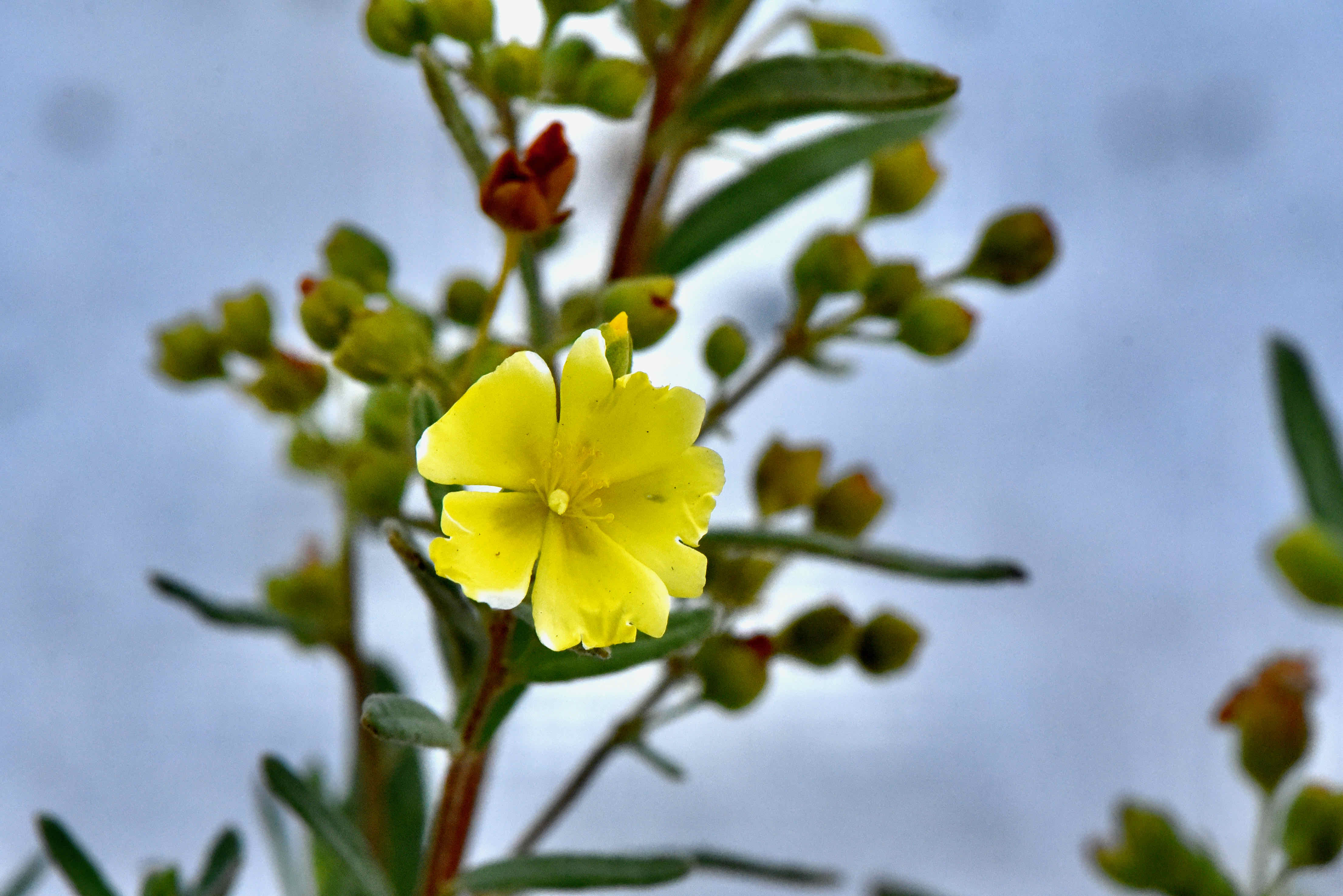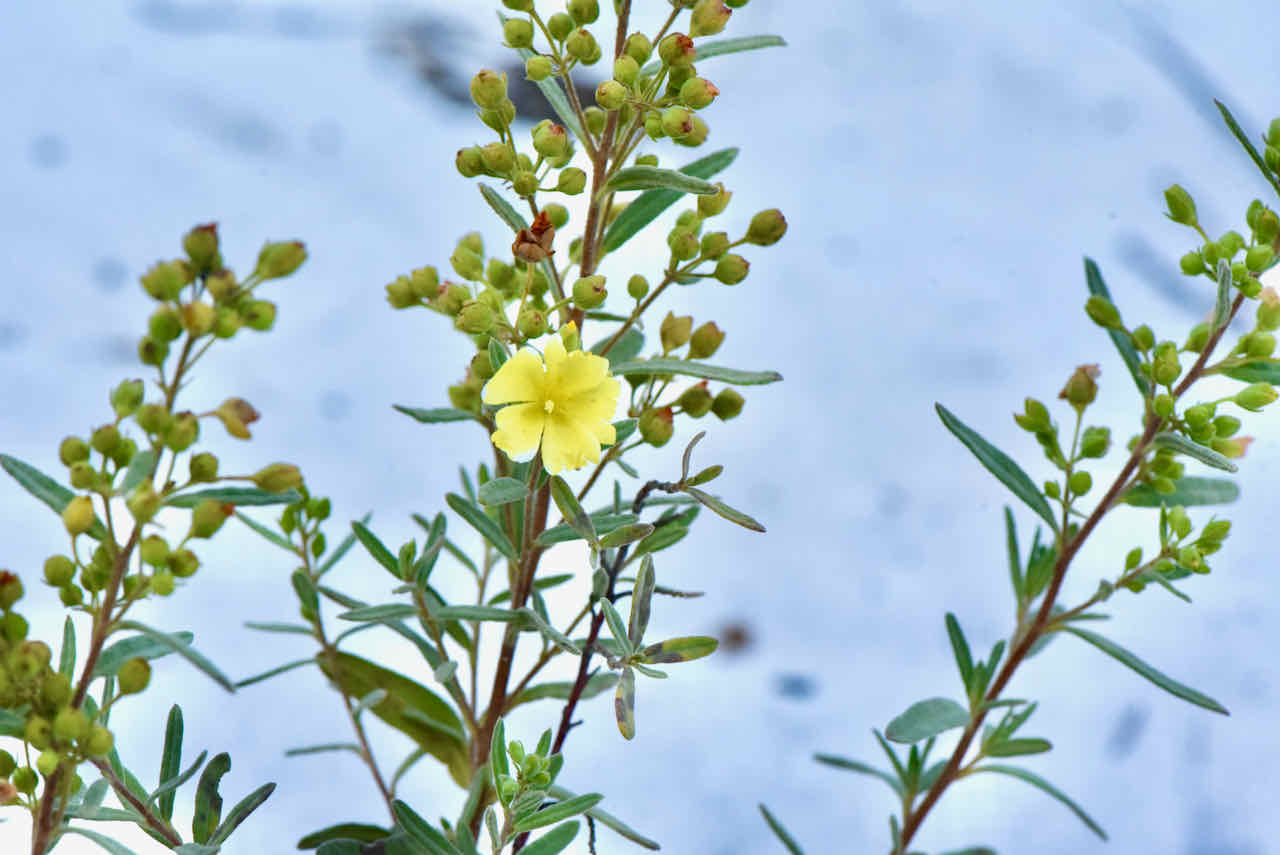
Florida scrub frostweed, photographed at Yamato Scrub Natural Area, Boca Raton, Palm Beach County, in March 2022.
Florida scrub frostweed, Crocanthemum nashii is a plant with a backup plan when it comes to producing offspring.
It puts out bright yellow flowers in hopes of attracting a hungry pollinator or two or three just like flowering plants generally do. If none come along, the plant will still produce seeds on its on via flowers that appear to be unopen buds. More on this in a bit.
Florida scrub frostweed is, as might be guessed from the name, a Florida native found in dry, hot sandy places. In fact it was considered endemic to Florida — meaning found in Florida and nowhere else on the planet — until 1997 when someone found it growing in New Hanover County along North Carolina’s southeastern shore, roughly 300 miles north of its northernmost locale in the Sunshine State. We’ve also seen some references to it growing in Georgia as well.
In Florida, it’s found in most peninsular counties between Alachua and Putnam to the north and Collier and Broward to the south, according to the U.S. Department of Agriculture’s PLANTS Database. The Atlas of Florida Vascular Plants puts Florida scrub frostweed’s northern limits in Nassau and Duval counties. (Links to both are below.)
It is a perennial; the Institute for Regional Conservation considers it rare in South Florida, though it can be plentiful in places where it does grow. The name tells you why: scrub. Florida scrub frostweed grows in dry, sandy habitats likes scrubs and scrubby flatwoods, which are rare, and which make it rare as well. Natureserve rates our guy an S3, meaning it is vulnerable to extinction, probably because of its limited range and habitats.
It’s a “subshrub,” growing between eight and 16 inches tall. Stems can be erect or angular; the base of the stems are woody. The leaves grow alternately along the stem; they’re linear — long and narrow — to slightly elliptical. Both the stems and leaves are covered with dense, fine hairs that give the plant a gray-green tone to it. The hairs help the plant retain water — remember, it grows in hot, dry habitats — and ward off hungry herbivore insects.
The gray-green look probably is one inspiration for its name, frostweed. It looks like it’s covered in frost. A second inspiration: when temperatures plummet to freezing or below, the leaves exude water, creating natural ice sculptures as they do. It’s not something that occurs all that frequently here is subtropical South Florida. Just to note, Florida scrub frostweed is not related to this frostweed.
Florida scrub frostweed blooms in the spring in northern portions of its range, probably all year farther south. The blooms are bright yellow, with five petals, about inch or less across. The stamen are orange-tinted and lie flat against the petals.
Flowering plants pollinate in two ways, either by outside forces — by wind transporting pollen from one flower to another or by birds and bugs — bees, butterflies, beetles, ants, etc. — doing the heavy lifting — or by themselves without any outside assistance.
When it’s done by outside forces, it’s called chasmogamous pollination; when its done internally, it’s called cleistogamous pollination.
Cleistogamous pollination is Florida scrub frostweed’s backup plan. If the yellow blooms don’t attract pollinators — chasmogamous pollination — and don’t produce seeds, a second round of flowers that look like unopened buds rather than fully developed blooms will produce seeds. Chasmogamous pollination provides genetic diversity but is hit or miss; cleistogamous pollination is more of a sure thing but the offspring are clones of the parent.
The fruit, by the way, is a small, hairy, three-segmented capsule.
To our knowledge, Florida scrub frostweed is not cultivated by commercial nurseries and has no other human uses.
Florida scrub frostweed likely has a symbiotic relationship with a soil fungus, an arrangement common among scrub plants. The fungus helps Florida scrub frostweed extract nutrients from nutrient-poor scrub soils. In return, the plant helps provide the fungus with moisture. This interaction with fungus is one reason why Florida scrub frostweed (and other scrub plants, for that matter) is difficult to cultivate.
Other common names include scrub sun rose, Florida scrub sun rose, sun rose and sun rose Florida scrub frostweed. It is a member of Cistaceae, the rock rose family. A quick taxonomic note: Florida scrub frostweed is commonly referred to as Helianthemum nashii.



